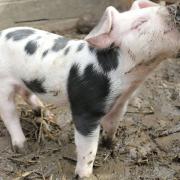A rubbed mane and tail is a common sight on a horse and pony in the summer months, and the majority of these cases are caused by a reaction to midge bites, called Sweet Itch explains Debbie Graham

This condition is called sweet itch or, to give its full veterinary name, summer seasonal recurrant dermatisis (SSRD) and is thought to affect around five percent of the equine population.
Equine veterinary surgeon Jessica Hill from Cheltenham Equine Vets says: “It is a hypersensitivity reaction to bites from Culicoides midges. Rarely, bites from other insects can cause a similar problem. The hypersensitivity leads to a recurrent seasonal allergic skin disease. During the process of repelling the insect saliva, the horse’s skin inflammation causes the clinical symptoms that are seen.”
She explains that it is rarely seen in foals and young horses, and symptoms usually start from around four years old and “the disease tends to worsen with advancing age.”
The signs we are all familiar with are the rubbed mane and tail, however in some cases the underside of the abdomen and ears can also be affected severely.

This means it is not only unsightly, particularly important if it is a show animal, but may also cause considerable distress and discomfort to the horse as they are unable to escape from incessant itching and midges.
Jessica explains: “This self-trauma leads to the hair loss, skin inflammation, loss of mane and tail hairs, and thickened skin, which are associated with sweet itch. Eventually the skin along the mane and top of the tail becomes thickened (lichenified) with hair loss and coarsening of the hair coat. The horse can lose weight because of the distraction of constant itching, rubbing and restlessness.”
And as of yet there is no cure. According to Jessica, the best treatment is “two-fold: avoidance of the allergen involved, which is vital, and reduction of the inflammatory response.”
Avoidance sounds difficult but is possible with careful thought. First, survey the patient’s environment.

According to Jessica, midges like standing water to breed, so ideally the horse should be kept away from this. However, woodlands, rivers, poorly drained land and muckheaps offer perfect conditions for midges to live in so a little reorganising, like repositioning your muckheap, could make all the difference.
As the midges are worse at dawn and dusk, stabling at these times is obviously preferable. However it does not stop there, as Jessica also recommends putting a mesh across open windows as this will help prevent them from entering (think of it working as a mosquito net). Fitting a fan is another option worth considering, as midges find it hard to fly in the breeze and if they can’t fly they can’t reach their victim.
Protective rugs, for example the Boett Rug, are invaluable to treat the disease, particularly if you are unable to stable your horse. They need to cover the horse from head to tail. For if the midge is only able to bite the rug then the horse will not be exposed to the saliva which causes the reaction.
Fly repellents can also play their part, with Deet and Benzyl Benzoate being two of the more effective and available from your vetertinary practice. But these have to be reapplied frequently, making it impractical day to day, but worth applying during exercise when the horse is out of its protected environment and vulnerable.
If the reaction is severe then corticosteroids can be given, either topically or systemically, but Jessica warns: “Systemic corticosteroids do carry a risk of side-effects such as laminitis.”
Yet there is hope. Greendale Veterinary Diagnostics Ltd has produced a desensitising programme called immunotherapy, which they say is beneficial to around 75 percent of cases. This involves a course of injections into the muscle that exposes the patient to a minute amount of the antigen which is then increased in strength, then amount, over time. The first series of injections lasts for approximately four months with injections every three to eight days, then the maintenance injections are given monthly.
Initially Jessica advises your veterinary surgeon carries out the injections in case of an anaphylactic reaction, but after the first few injections the owner can carry on. The programme must start before sweet itch season and any improvement is usually seen between four and twelve months later. For more information speak to your veterinary practice.
A product developed in 2010, Bio Eos Sweet Itch Capsules, attempts to reduce the immune response to more like that of a normal horse. It was developed by Professor John Standford and his team at BioEos and has been co-ordinated by The National Sweet Itch Centre. According to trials held before the product was released, in 70 per cent of the cases there was around a 50 per cent improvement and in 10 per cent there was an improvement of 90 per cent. Jessica also mentions two other treatments that are worth considering; Calvalesse and Hippo-Ex-Cema.
“Calvalesse is a natural food supplement containing Nicotinamide, which inhibits histamine release and reduces the inflammatory response in the skin. It comes in the form of an oral solution and a topical gel. Hippo-Ex-Cema is also a natural food supplement containing vitamins and polypeptides aimed at assisting the immune system of the skin.”
However it is a combination of all these approaches that perhaps is the key.
Jessica says: “Sweet Itch is an infuriating and difficult disease to cope with for both horse and owner. There are many management options, the most essential being the protection of the horse from the midge bites.”
Laminitis is also common summer problem that can have serious implications. Vet Jessica Hill passes on her tips and knowledge

























